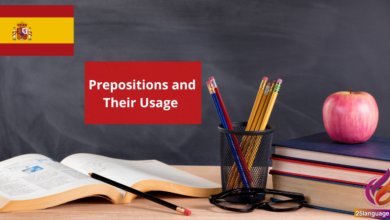The Difference Between “Por” and “Para”

Unlocking the nuances of Spanish can transform your conversations from basic to breathtaking! today, we delve into two seemingly simple words-“por” and “para”-that can change the meaning of your sentences entirely. While both mean “for,” they serve distinct purposes that reveal subtleties in intention, time, and action. By mastering these prepositions, you’ll enhance your fluency and express yourself more accurately in Spanish, making your journey into the language even more rewarding!
Understanding Por and Para in Spanish: Key differences and Usage
In Spanish, “por” and “para” are both prepositions that can translate to “for” in English, but their usage is distinct and context-dependent.Understanding when to use each one is crucial for mastery of Spanish. “Por” is often used to express the reason behind an action, the duration of time, or the means by which something is done. For example, in the sentence, “Lo hago por ti” (I do it for you), “por” indicates motivation. Further, we can say, “Estuve esperando por dos horas” (I was waiting for two hours), which emphasizes the length of time.
Conversely,”para” generally denotes purpose,destination,or recipient. When you say, “Este regalo es para ti” (This gift is for you), you are identifying the recipient. To denote purpose, consider: “Estudia para aprender” (Study in order tolearn), where “para” indicates the aim of the studying. Lastly, “para” is used to indicate deadlines, such as in “La tarea es para mañana” (The homework is for tomorrow), which specifies a time limit.
| Spanish Example | Rule | English Translation |
|---|---|---|
| Lo hago por ti | Reason / motivation | I do it for you |
| estuve esperando por dos horas | Duration of time | I was waiting for two hours |
| Este regalo es para ti | Recipient | This gift is for you |
| Estudia para aprender | Purpose | Study in order to learn |
| La tarea es para mañana | Deadline | The homework is for tomorrow |
Mastering Por and Para: Practical Examples for Everyday Conversations
In Spanish, por and para are prepositions that can often confuse learners due to their similar usages. However, they have distinct meanings and contexts. Por generally indicates motive, cause, or reason, while para expresses purpose or aim. To better understand the use of these prepositions,consider the following examples:
- Por: “Lo hice por ti.” (I did it for you-implying a reason or motive.)
- Para: “Este regalo es para ti.” (This gift is for you-indicating who the gift is intended for.)
Here’s a breakdown of some common uses:
| Spanish Example | Rule | english Translation |
|---|---|---|
| Viajamos por España. | Expressing movement through a place. | We traveled through Spain. |
| Estudio para aprender. | Expressing purpose or intention. | I study to learn. |
| Gracias por la ayuda. | Expressing gratitude or motive. | Thank you for the help. |
| Es un libro para niños. | Indicating intended use. | it is indeed a book for children. |
Navigating Por vs. Para: Expert Tips for Effective Communication
When learning Spanish, understanding when to use “por” versus “para” is crucial for effective communication. Both prepositions translate to “for” in English,but their applications differ considerably. Here are some guidelines to help you navigate their usage:
- Por is often used to express reasons, durations, or exchanges.For instance:
- Lo hice por ti. (I did it for you.)
- Caminé por dos horas. (I walked for two hours.)
- Pagué diez dólares por el libro. (I paid ten dollars for the book.)
- Para is used for purposes, destinations, or deadlines. For example:
- Este regalo es para ti.(This gift is for you.)
- Salgo para españa mañana.(I leave for Spain tomorrow.)
- La tarea es para el lunes. (The homework is due for Monday.)
| Spanish Example | Rule | English Translation |
|---|---|---|
| Lo hice por ti. | Reason | I did it for you. |
| Caminé por dos horas. | Duration | I walked for two hours. |
| Pagué diez dólares por el libro. | Exchange | I paid ten dollars for the book. |
| Este regalo es para ti. | Purpose | This gift is for you. |
| Salgo para España mañana. | Destination | I leave for Spain tomorrow. |
| La tarea es para el lunes. | Deadline | The homework is due for Monday. |
Clarifying Por and Para: A Comprehensive Guide to Spanish Prepositions
In Spanish, the prepositions por and para can often confuse learners due to their overlapping uses.However, understanding their distinct meanings is crucial for mastering their use. Por is typically used to express reasons or motivations, a duration of time, and means of communication or transportation. For example:
- Viajo por tren. (I travel by train.)
- lo hice por ti. (I did it for you.)
- Estudiamos por dos horas. (We studied for two hours.)
In contrast, para denotes purpose, intended recipients, deadlines, and destinations. Here are some examples:
- Este regalo es para ti. (This gift is for you.)
- Termina el trabajo para mañana.(Finish the work by tomorrow.)
- Voy para la playa. (I am going to the beach.)
| Spanish Example | Rule | English Translation |
|---|---|---|
| Viajo por tren. | Means of transportation | I travel by train. |
| Lo hice por ti. | Reason or motivation | I did it for you. |
| Estudiamos por dos horas. | Duration of time | We studied for two hours. |
| Este regalo es para ti. | Intended recipient | This gift is for you. |
| Termina el trabajo para mañana. | Deadline | Finish the work by tomorrow. |
| Voy para la playa. | Destination | I am going to the beach. |
Insights and Conclusions
Conclusión: La Diferencia Entre “Por” y “Para”
¡Felicidades por completar esta lección sobre las diferencias entre “por” y “para”! Hoy hemos abordado un tema fundamental en el español que puede enriquecer significativamente su comunicación. Recapitulamos que “por” se utiliza para expresar causa,medio,o intercambio,mientras que “para” se enfoca en propósito,destinatario o dirección.
Recordemos que comprender cuándo y cómo usar cada preposición no solo clarifica su mensaje, sino que también demuestra su dominio del idioma.La práctica es clave, así que les animo a que sigan buscando oportunidades para usar “por” y “para” en sus conversaciones, escritos y ejercicios.
No duden en organizar frases o crear diálogos, ya sea con amigos, compañeros de clase o incluso en sus propios pensamientos. Cada esfuerzo cuenta y les acerca un paso más a la fluidez.
¡Sigan adelante! Con cada pequeño avance, están construyendo una base sólida en su viaje de aprendizaje del español.¡Ánimo y hasta la próxima lección!





























